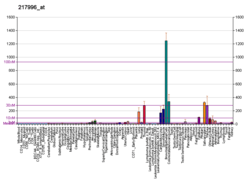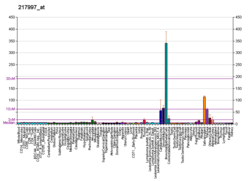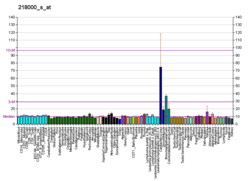PHLDA1
Pleckstrin homology-like domain family A member 1 (PHLDA1) is a protein that in humans is encoded by the PHLDA1 gene.[5][6][7]
| PHLDA1 | |||||||||||||||||||||||||
|---|---|---|---|---|---|---|---|---|---|---|---|---|---|---|---|---|---|---|---|---|---|---|---|---|---|
| Identifiers | |||||||||||||||||||||||||
| Aliases | PHLDA1, DT1P1B11, PHRIP, TDAG51, pleckstrin homology like domain family A member 1 | ||||||||||||||||||||||||
| External IDs | OMIM: 605335 MGI: 1096880 HomoloGene: 7203 GeneCards: PHLDA1 | ||||||||||||||||||||||||
| |||||||||||||||||||||||||
| |||||||||||||||||||||||||
| |||||||||||||||||||||||||
| |||||||||||||||||||||||||
| Orthologs | |||||||||||||||||||||||||
| Species | Human | Mouse | |||||||||||||||||||||||
| Entrez | |||||||||||||||||||||||||
| Ensembl | |||||||||||||||||||||||||
| UniProt | |||||||||||||||||||||||||
| RefSeq (mRNA) | |||||||||||||||||||||||||
| RefSeq (protein) | |||||||||||||||||||||||||
| Location (UCSC) | Chr 12: 76.03 – 76.03 Mb | Chr 10: 111.51 – 111.51 Mb | |||||||||||||||||||||||
| PubMed search | [3] | [4] | |||||||||||||||||||||||
| Wikidata | |||||||||||||||||||||||||
| |||||||||||||||||||||||||
This gene encodes an evolutionarily conserved proline-histidine rich nuclear protein. The encoded protein may play an important role in the anti-apoptotic effects of insulin-like growth factor-1.[7]
References
- GRCh38: Ensembl release 89: ENSG00000139289 - Ensembl, May 2017
- GRCm38: Ensembl release 89: ENSMUSG00000020205 - Ensembl, May 2017
- "Human PubMed Reference:". National Center for Biotechnology Information, U.S. National Library of Medicine.
- "Mouse PubMed Reference:". National Center for Biotechnology Information, U.S. National Library of Medicine.
- Neef R, Kuske MA, Prols E, Johnson JP (Oct 2002). "Identification of the human PHLDA1/TDAG51 gene: down-regulation in metastatic melanoma contributes to apoptosis resistance and growth deregulation". Cancer Res. 62 (20): 5920–9. PMID 12384558.
- Toyoshima Y; Karas M; Yakar S; Dupont J; Lee Helman; LeRoith D (Jun 2004). "TDAG51 mediates the effects of insulin-like growth factor I (IGF-I) on cell survival". J Biol Chem. 279 (24): 25898–904. doi:10.1074/jbc.M400661200. PMID 15037619.
- "Entrez Gene: PHLDA1 pleckstrin homology-like domain, family A, member 1".
- Hinz, T; Flindt S; Marx A; Janssen O; Kabelitz D (May 2001). "Inhibition of protein synthesis by the T cell receptor-inducible human TDAG51 gene product". Cell. Signal. England. 13 (5): 345–52. doi:10.1016/S0898-6568(01)00141-3. ISSN 0898-6568. PMID 11369516.
Further reading
- Reddy PH, Stockburger E, Gillevet P, Tagle DA (1998). "Mapping and characterization of novel (CAG)n repeat cDNAs from adult human brain derived by the oligo capture method". Genomics. 46 (2): 174–82. doi:10.1006/geno.1997.5044. PMID 9417904.
- Kuske MD, Johnson JP (2000). "Assignment of the human PHLDA1 gene to chromosome 12q15 by radiation hybrid mapping". Cytogenet. Cell Genet. 89 (1–2): 1. doi:10.1159/000015575. PMID 10894922.
- Hinz T, Flindt S, Marx A, et al. (2001). "Inhibition of protein synthesis by the T cell receptor-inducible human TDAG51 gene product". Cell. Signal. 13 (5): 345–52. doi:10.1016/S0898-6568(01)00141-3. PMID 11369516.
- Strausberg RL, Feingold EA, Grouse LH, et al. (2003). "Generation and initial analysis of more than 15,000 full-length human and mouse cDNA sequences". Proc. Natl. Acad. Sci. U.S.A. 99 (26): 16899–903. Bibcode:2002PNAS...9916899M. doi:10.1073/pnas.242603899. PMC 139241. PMID 12477932.
- Hossain GS, van Thienen JV, Werstuck GH, et al. (2003). "TDAG51 is induced by homocysteine, promotes detachment-mediated programmed cell death, and contributes to the cevelopment of atherosclerosis in hyperhomocysteinemia". J. Biol. Chem. 278 (32): 30317–27. doi:10.1074/jbc.M212897200. PMID 12738777.
- Oberg HH, Sipos B, Kalthoff H, et al. (2005). "Regulation of T-cell death-associated gene 51 (TDAG51) expression in human T-cells". Cell Death Differ. 11 (6): 674–84. doi:10.1038/sj.cdd.4401407. PMID 15002043.
- Meier-Noorden M, Flindt S, Kalinke U, Hinz T (2004). "A CpG-rich bidirectional promoter induces the T-cell death-associated gene 51 and downregulates an inversely oriented transcript during early T-cell activation". Gene. 338 (2): 197–207. doi:10.1016/j.gene.2004.05.006. PMID 15315823.
- Gerhard DS, Wagner L, Feingold EA, et al. (2004). "The status, quality, and expansion of the NIH full-length cDNA project: the Mammalian Gene Collection (MGC)". Genome Res. 14 (10B): 2121–7. doi:10.1101/gr.2596504. PMC 528928. PMID 15489334.
- Rual JF, Venkatesan K, Hao T, et al. (2005). "Towards a proteome-scale map of the human protein-protein interaction network". Nature. 437 (7062): 1173–8. Bibcode:2005Natur.437.1173R. doi:10.1038/nature04209. PMID 16189514.
This article is issued from Wikipedia. The text is licensed under Creative Commons - Attribution - Sharealike. Additional terms may apply for the media files.






